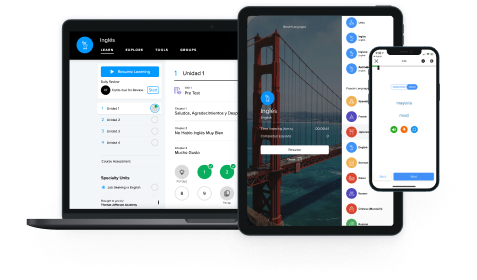Unlike the English “-ing” forms, German present participles never used to form tenses. So you won’t use a present participle to translate a sentence like “John is eating a slice of pizza” into German. German has different ways to express such progressivity. Check out our post on progressivity in German to learn more!

How to form and use present participles in German?
In German, the present participle(Partizip Präsens) is a form of a verb that is most often used as an adjective. It is generally formed by adding -d to the infinitive form of a verb. This ending is then followed by the appropriate adjective agreement endings:
Die stehenden Gäste waren schon müde.
The standing guests were already tired.
Die Rede des Politikers machte die Protestanten sehr wütend.
The speech of the politician made the protesters very angry.
Though German present participles are generally used as adjectives, they can also be used as adverbs or even nouns. In all its uses, though, the present participle form represents an action in progress or situation still in place at the time being discussed. In this article we will talk about the different ways of using and forming the present participle in German.
What is a present participle in German?
In German, a present participle is a form of a verb that is most often used as an adjective.
schreiben(to write) → schreibend(writing)
hören(to hear) → hörend(hearing)
There are two types of participles in German — the present participle(Partizip I / Partizip Präsens) and the past participle(Partizip II / Partizip der Vergangenheit).
The present participle is used to describe situations or actions that are still in progress at the moment being described. These are the equivalents of “-ing” forms in English.
present participleManfred rief seine Mutter später zu Abend essend zurück.
Manfred called his mother back later while eating dinner.
The past participle is used for completed actions and is therefore used not only as an adjective, but also to form the perfect tenses. These are the equivalent of the “-en” or “-ed” forms in English.
past participleManfred war gerade nach Hause gekommen, als sein Handy klingelte.
Manfred had just come home when his cell rang.
Important
How to form the present participle in German?
In German forming the present participle is pretty simple and straightforward: You just add -d to the infinitive form of the verb.
Infinitive | Present Participle |
|---|---|
schreiben to write | schreibend writing |
hören to hear | hörend hearing |
sprechen to speak | sprechend speaking |
lächeln to smile | lächelnd smiling |
bunkern to bunker | bunkernd bunkering |
If you want to use your present participle as an adjective, you’ll then need to decline it like a regular adjective, if that’s what it’s used for. We’ll talk more about the different use cases below.
Exception!
As always there are some exceptions — German never disappoints in this regard! 😉
Verbs whose infinitive ends in -n rather than in -en replace the infinitive -n with -end:
Infinitive | Present Participle |
|---|---|
sein to be | seiend writing |
tun to do | tuend doing |
When to use the present participle in German?
Present participles can be used for different reasons in German. Here are four:
As an attributive adjective, before a noun:
In German, present participles are most often used directly before the noun they describe, as an “attributive adjective.”
present participlenounDas Kind wischte sich den tropfenden Mund ab.
The child wiped its dripping mouth.
In this use, they are just like any other adjective. This is why the participle in the example above ends with -en — it is an ending.
As a predicative adjective, after a verb like sein(to be):
Present participles can be used after like sein(to be), blieben(to stay/remain) and werden(to become; will).
linking verbpresent participleDie neue Entdeckung war lange Zeit führend in der Medizin.
The new discovery was leading for a long time in the medical field.
When used predicatively, present participles are not declined, so you don’t need to add agreement endings.
As an adverb, to describe a simultaneous action:
Present participles can also modify a verb, to add information about something happening at the same time as the main action.
verbpresent participleDanach verließ die Frau lachend das Zimmer.
Afterwards the woman left the room laughing.
Die Frau schrie wütend aus dem Fenster.
The woman yelled angrily out of the window.
lit. The woman yelled being angry out of the window.
In this use, they can be part of extended phrases that describe a verb, like a . Compare the two sentences below:
- present participle phraseverb
Ein wichtiges Telefonat führend ging er in den Park.
(While) making an important phone call, he went to the park.
- verbsubordinate clause
Er ging in den Park, während er ein wichtiges Telefonat führte.
He went to the park while he was making an important phone call.
As nouns:
You can turn basically any present participle into a noun just by adding -e (singular) or -en (plural) to the end of it. From there, you basically decline it like any other noun. The noun always represent someone or something that does an action (in English, these nouns generally end in “-er”).
present participleDie Streikenden verlangen mehr Geld.
The people on strike are demanding more money.
Niemand konnte dem Reisenden am Bahnhof helfen.
Nobody was able to help the traveler at the train station.
Check out our post on German nominalization to learn other ways to turn verbs into nouns!
Words that were historically present participles
Some German words were present participles once upon a time, but have become independent from the base verb they were built from over time. Such words are now generally considered adjectives, not participles. For example:
Der neue Film ist wirklich spannend.
The new movie is really exciting.
Kann ich dich heute Abend sprechen? Ich habe eine dringende Nachricht für dich.
Can I talk to you tonight? I have an urgent message for you.
Here are a few other adjectives in German that were historically present participles:
German | English |
|---|---|
bahnbrechend | groundbreaking |
auffallend | striking |
reizend | lovely |
dringend | urgent |
anscheinend | apparently |
ansteckend | contagious |
entscheidend | crucial |
wütend | angry |
abwertend | derogatory |
bedeutend | meaningful |
herablassend | condescending |
Summary
Here are the most important take-aways about German present participles:
They are mostly formed by adding -d to the end of the infinitive.
They describe an action or situation that is in-progress, like the English “-ing” forms, but unlike in English, they are not used to create tenses.
They are most often used as attributive adjectives, but can also act as predicate adjectives, adverbs, and even form the base of nouns.
And now, head on over to our German present participle activities! It’s time to practice!
